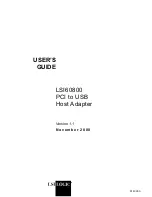
21020285 D
User’s Guide
Chapter 3 Hardware Installation
Page 3 - 14
Step 5: Configure and Connect SCSI Devices
Step 5:
Configure and
Connect SCSI
Devices
The RF3880 can communicate with any SCSI device that adheres to the SCSI
Common Command Set. Each separate device on the SCSI bus must have a
unique SCSI ID and be properly terminated. In addition, it may have a self-test
sequence or options and parameters that you should know about.
You will need to examine the documentation that arrives with your selected
peripheral for more information. This section outlines what to look for.
Selectable
Options
Each peripheral vendor can choose a unique way to assign a SCSI ID and
enable/disable options. The two most common methods are: jumpers and
switches.
You will need to find the section in your peripheral documentation that explains
how to set the options.
SCSI ID
You will need to decide which SCSI ID to assign to your peripheral(s). Bus
access priority is given to a device based on the SCSI ID it is assigned. The
SCSI ID’s zero to seven have higher priority than eight through 15, and priority
descends from seven to zero, and 15 to eight. See the SCSI 3 specification for
more information on this. Each device on the SCSI bus (including the RF3880)
must have a unique SCSI ID. The factory-set ID for the RF3880 adapter is zero.
Options
Your device may also have a means to select options such as: termination power
source, automatic spin-up, or parity checking.
Termination Power:
If your hard disk is the last peripheral on the SCSI bus,
it will need to have terminators installed. Some hard drives allow you to select
whether the terminators will get power locally, on the drive, or use the
termination power available on the SCSI cable. Setting up the drive to provide
its own terminator power is the most universal solution. The RF3880 provides
TERM PWR on the SCSI cable.
Automatic Spin-up:
Some disk drives allow you to delay spin-up of the disk
media until a SCSI command is issued to spin it up. The advantage to this is
that it cuts down the power draw when the system is initially turned on.
Parity Checking:
The RF3880 is flexible enough to allow you to use SCSI
bus parity checking or disable it. If you wish to use it, parity checking must be
enabled on each peripheral and also enabled using the General Options
command explained in Chapter 7. Note that all devices on the SCSI bus must
be setup for parity the same way.
You can select a power-up/reset default for parity checking with pins 5 and 6
of the SCSI Configuration Jumper Block. The value you use in the General
Options command overrides the jumper setting, so you should be sure that they
match. (You would install a jumper over the pins to disable parity checking.)
Moreover, you can use the Board Information Board-control command to
discover the current setting of the parity jumper without removing the board.
See Chapter 7 for more information on Board-control commands.
Termination
The devices at each physical end of the SCSI bus cable must have terminating
Summary of Contents for Rimfire 3880
Page 1: ...Rimfire 3880 SCSI Host Bus Adapter User s Guide Ciprico Inc Publication No 21020285 D...
Page 2: ......
Page 4: ...21020285 D User s Guide...
Page 25: ...2 H a r d w a r e E s s e n t i a l s...
Page 42: ...21020285 D User s Guide Chapter 2 Hardware Essentials Page 2 18 Descriptions of Port Usage...
Page 43: ...3 H a r d w a r e I n s t a l l a t i o n...
Page 59: ...4 C o m m a n d O p e r a t i o n...
Page 85: ...5 I n i t i a t o r M o d e P a s s t h r o u g h C o m m a n d s...
Page 103: ...6 T a r g e t M o d e P a s s t h r o u g h C o m m a n d s...
Page 125: ...7 B o a r d c o n t r o l C o m m a n d s...
Page 175: ...8 D e t a i l s o f U s a g e...
Page 193: ...A E r r o r C o d e s...
Page 201: ...B C a b l e s a n d C o n n e c t o r s...
Page 206: ...21020285 D User s Guide Appendix B Cables and Connectors Page B 6 VMEbus Connector Pinouts...
Page 207: ...C S p e c i f i c a t i o n s...
Page 210: ...21020285 D User s Guide Appendix C Specifications Page C 4 Specifications...
Page 211: ...D D e f a u l t s...
Page 216: ...21020285 D User s Guide Appendix D Defaults Page D 6 HardwareDefaults...
Page 217: ...E D e s i g n D i f f e r e n c e s...
Page 229: ......
Page 230: ...21020285 D...
















































